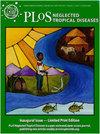墨西哥南部沙蝇 Psathyromyia cratifer 的数量和利什曼原虫感染模式
IF 3.4
2区 医学
Q1 Medicine
引用次数: 0
摘要
背景局部皮肤利什曼病(LCL)是墨西哥南部一个严重的公共卫生问题。已发现六种Phlebotominae(双翅目:Psychodidae)可感染该地区利什曼病的病原体--墨西哥利什曼病(Leishmania)。然而,人们对 Psathyromyia cratifer 在墨西哥和美洲利什曼病传播周期中的生物学特性和潜在参与知之甚少。本研究提供了 Psathyromyia cratifer 暂时感染利什曼原虫的证据,以及在众所周知的墨西哥南部利什曼原虫传播周期中,Psathyromyia cratifer 在利什曼原虫流行区的种群动态数据。方法/主要发现 在五个月的时间里(2020 年 11 月至 2021 年 3 月),使用动物诱饵、人类诱饵和灯光诱捕器在四个地点收集了 Psathyromyia cratifer 的个体标本。评估了 Psathyromyia cratifer 的时间活动模式(月+小时)及其与环境变量的关系。此外,还对雌性沙蝇的利什曼病DNA和血餐进行了分析和检测。这表明感染率从 8%到 83%不等,并记录了智人和 Ototylomys phyllotis 作为这种沙蝇的血液宿主。这些沙蝇在人诱饵诱捕器中的高丰度记录显示了 Psathyromyia cratifer 的明显嗜人行为。至于寄生虫在该地区的传播动态,研究发现,在 1 月和 3 月期间,沙蝇传播利什曼病的潜在流行病学风险最高。结论 这是首次对 Psathyromyia cratifer 的种群动态和利什曼原虫的时间流行模式做出的贡献。研究结果表明,这种沙蝇标本是墨西哥南部第六种潜在的莱什曼原虫病媒。尽管如此,各种生物学、行为学和生态学方面的问题仍有待解决。后者是为了确定它在该地区以及该国其他地区的寄生虫传播动态中所扮演的角色。本文章由计算机程序翻译,如有差异,请以英文原文为准。
Abundance and Leishmania infection patterns of the sand fly Psathyromyia cratifer in Southern Mexico
Background Localized cutaneous leishmaniasis (LCL) is a serious public health problem in Southern Mexico. Six species of Phlebotominae (Diptera: Psychodidae) have been found to be infected with Leishmania (Leishmania) mexicana , the causative agent of LCL in the region. However, little is known about the biology and potential participation of Psathyromyia cratifer in the Leishmania transmission cycle in Mexico, and the Americas. The present study provides evidence of temporal infection caused by Leishmania in Psathyromyia cratifer as well as data on its population dynamics in a LCL endemic area during the well-known transmission cycle of Leishmania in Southern Mexico. Methodology/Principal findings Individual specimens of Psathyromyia cratifer were collected in four sites over the course of five months (from November 2020 through March 2021) using animal-baited, human-baited, and light traps. The temporal activity pattern (month + hour) of Psathyromyia cratifer was assessed along with its relationship with environmental variables. Moreover, Leishmania DNA and blood meals were analyzed and detected in female sand flies. This evidenced an infection rate ranging from 8% to 83%, and the record of Homo sapiens and Ototylomys phyllotis as blood hosts of this sand fly species. High abundances of these sand flies in human-baited traps were recorded which revealed the marked anthropophilic behavior of Psathyromyia cratifer . As regards the transmission dynamics of the parasite within the region, it was observed that the potential highest epidemiological risk for Leishmania transmission by Psathyromyia cratifer occurred during the months of January and March. Conclusion This is the first contribution ever made to both the population dynamic and the temporal Leishmani a prevalence patterns in Psathyromyia cratifer . The resulting findings suggest that this sand fly specimen is the sixth potential vector of L . (L .) mexicana in Southern Mexico. Nonetheless, various biology, behavior, and ecology strands are yet to be addressed. The latter, to determine the role it plays in the transmission dynamics of the parasite within the region, and other areas of the country.
求助全文
通过发布文献求助,成功后即可免费获取论文全文。
去求助
来源期刊

PLoS Neglected Tropical Diseases
Medicine-Infectious Diseases
CiteScore
7.40
自引率
10.50%
发文量
723
审稿时长
2-3 weeks
期刊介绍:
PLOS Neglected Tropical Diseases publishes research devoted to the pathology, epidemiology, prevention, treatment and control of the neglected tropical diseases (NTDs), as well as relevant public policy.
The NTDs are defined as a group of poverty-promoting chronic infectious diseases, which primarily occur in rural areas and poor urban areas of low-income and middle-income countries. Their impact on child health and development, pregnancy, and worker productivity, as well as their stigmatizing features limit economic stability.
All aspects of these diseases are considered, including:
Pathogenesis
Clinical features
Pharmacology and treatment
Diagnosis
Epidemiology
Vector biology
Vaccinology and prevention
Demographic, ecological and social determinants
Public health and policy aspects (including cost-effectiveness analyses).
 求助内容:
求助内容: 应助结果提醒方式:
应助结果提醒方式:


